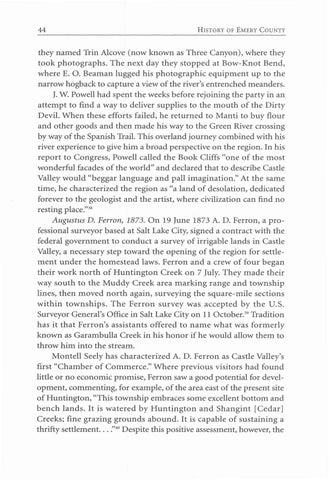they named Trin Alcove (now known as Three Canyon), where they took photographs. The next day they stopped at Bow-Knot Bend, where E. 0. Beaman lugged his photographic equipment up to the narrow hogback to capture a view of the river's entrenched meanders. J. W. Powell had spent the weeks before rejoining the party in an attempt to find a way to deliver supplies to the mouth of the Dirty Devil. When these efforts failed, he returned to Manti to buy flour and other goods and then made his way to the Green River crossing by way of the Spanish Trail. This overland journey combined with his river experience to give him a broad perspective on the region. In his report to Congress, Powell called the Book Cliffs "one of the most wonderful facades of the world" and declared that to describe Castle Valley would "beggar language and pall imagination." At the same time, he characterized the region as "a land of desolation, dedicated forever to the geologist and the artist, where civilization can find no resting placelV8 Augustus D. Ferron, 1873. On 19 June 1873 A. D. Ferron, a professional surveyor based at Salt Lake City, signed a contract with the federal government to conduct a survey of irrigable lands in Castle Valley, a necessary step toward the opening of the region for settlement under the homestead laws. Ferron and a crew of four began their work north of Huntington Creek on 7 July. They made their way south to the Muddy Creek area marking range and township lines, then moved north again, surveying the square-mile sections within townships. The Ferron survey was accepted by the U.S. Surveyor General's Office in Salt Lake City on 11 O~tober.'~ Tradition has it that Ferron's assistants offered to name what was formerly known as Garambulla Creek in his honor if he would allow them to throw him into the stream. Monte11 Seely has characterized A. D. Ferron as Castle Valley's first "Chamber of Commerce." Where previous visitors had found little or no economic promise, Ferron saw a good potential for development, commenting, for example, of the area east of the present site of Huntington, "This township embraces some excellent bottom and bench lands. It is watered by Huntington and Shangint [Cedar] Creeks; fine grazing grounds abound. It is capable of sustaining a thrifty settlement. . . I"' Despite this positive assessment, however, the
Utah Centennial County History Series - Emery County 1996

Issuu converts static files into: digital portfolios, online yearbooks, online catalogs, digital photo albums and more. Sign up and create your flipbook.











